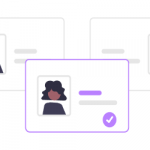If customer journey mapping is a rocket that takes your UX up in the sky, then information is its fuel. Carefully gathered data is a key to building a successful CJM as it is a key to pretty much everything else. So you want that juicy slice of data. And not just a slice, you want the whole pie. Everybody wants some. And UXPressia’s here to give you just that.
If you read our post ‘The 6 targets you will hit with CJM’ then you’re probably wondering where to go from here and what sources of data are good for building a customer journey map of your own. The answer is simple – all sources are great. But let’s be more specific and go over each of our options.
Whatever research we are going to run will fall into either of these two categories: analytical or anecdotal. They’re also called quantitative and qualitative respectively. The first comprises all the dry data we can gather – numbers, web analytics and the rest of the digital stuff. It is effective but only when bundled with the second one which includes all the good old ‘analog stuff’ such as interviews, focus groups and so on. Theory aside, let’s get to practical steps you can make to equip your team with everything they need to start mapping!

Start from the bottom
Sometimes it is hard to knock out resources for a whole new survey so you need to find a way out and that is going with what you already have. You can use your team’s experience and knowledge collected during the earlier stages of development. It is likely that you’ve already conducted some customer studies so start with that internal analytics. Brainstorm with your team based on what you know and that will be good for the start. Once the stakeholders see positive changes, they’ll be more likely to allocate budget for a more comprehensive survey.
Go with your gut
If the previous option is not your case due to either lack of budgeting resources or lack of already gathered internal data or both it’s not a reason to give up. All you’ll have to do is to use your imagination. You still have a good understanding of your product or service, right? That might be just enough to start with CJM. Gather your team and try to come up with some ideas, bounce them off each other. Imagine what kind of people will use your service and what they want to achieve. Making hypothesis is not that bad of a thing when there’s nothing left to do. Surely you can make fairly real personas with what you have but in the end, try to make some proof for your assumptions. Oh, and don't forget to make personas with our Personas Online tool!
Go virtual
The web is a goldmine of data and you want to take the best of it. Turn to web analytics to see your customers’ background and study search data to know their goals. Read reviews on your products that customers leave all over the Internet. Tools like Mention will cover your back here. Dig in tech support logs and customer feedback to enlighten on what struggles your users go through. Social media is the next stop. You can study user profiles to know who they really are. Go ahead and be creative!
Down to earth

Don’t forget to ask users personally. There are so many ways in which you can interact with customers to get your hand on that real stuff.
- Call your users or invite them for an interview! There was a striking case described in a famous book called Service Design. The management of an insurance company including top executives was to make calls to real customers to get feedback as a part of company’s new UX strategy. This experience turned out to be a breath of fresh air for staff who got caught up in numbers. It reminded them of their past when such interactions sparked interest in business. On top of that, seeing top management talking to customers affected the rest of the organization.
- Conduct context inquiries, do usability testing. It can be done not only with users but also with company representatives who work with customers. Speaking of your own staff, listen to what they have to say as front-line employees may bring some valuable insights.
- Ask your customers to take a survey but make it fun and don’t forget to reward them. Connect with them on social media, do focus groups and whatever gets you that sweet info you’re searching for. As long as there’s no stalking and kidnapping involved!
- Do not stop here and invite your users to participate in a CJM workshop later! This will definitely change the way you design your user experience.

Going undercover
Sneak a peek at what’s going on in your rivals’ yards. There might be some valuable lessons you can take. Learning from others’ mistakes or successes has always been a trait of smart people. And the final step you can take is to become a secret agent or to put it simply – a mystery shopper and to experience your service yourself.
Once equipped with all the info you’re good to start mapping journeys of your customers. Don’t put off till tomorrow what you can start doing now. At UXPressia there’s a rule - bring your own data and a map template is on the house. We prefer to stick to this rule, so why don’t you go at https://uxpressia.com and check it yourself?





